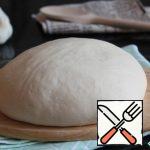Knead the dough. Oil can be added immediately, but this is not good! Usually I do this – I start kneading with a spoon, and then just pour the oil a little bit on my hand and gradually mix it into the dough… Knead until “smooth”. Minutes 10 … 12. Please note-with such a degree of hydration of our flour, the dough will still stick to your hands. And to the table. Another point: kneading the dough on ice water requires physical effort. At the very beginning, you will probably think that the dough is “oak”. Do not rush to conclusions – finish it to the end. Also, with manual kneading, it is unlikely that you will be able to knead the dough to the same state as in the dough mixer. Don’t bother! 10 minutes by hand-enough for 2, 3 pizzas. If you will knead in the car-I can tell you the time only for the spiral dough mixer. 18 minutes. In general, for machine kneading, there are a couple of indicators of dough readiness: the dough begins to “click”at the end of the kneading. Air bubbles burst and it turns out such a shooting sound. The dough should not spread out on the bowl or bowl of the machine, but should be collected in a lump around the working mechanism. A few words about flour: although we have it all weak, but a small +\- still there. If you decide to prepare the dough according to these recipes-I advise you to do it clearly for the first time according to the layout. It will not be hard in any case, and if it turns out to be too soft-sticky – reduce the next time by 3…4 percent of water.
 Lush Pizza with Spinach Dough Recipe
Lush Pizza with Spinach Dough Recipe
 Vegetable Pizza on Beet Dough Recipe
Vegetable Pizza on Beet Dough Recipe
 Thin Pizza Dough Recipe
Thin Pizza Dough Recipe
 Dough for Very Thin Pizza Recipe
Dough for Very Thin Pizza Recipe
 Pizza-tart with Baked Pepper Recipe
Pizza-tart with Baked Pepper Recipe
 Pizza Dough of Squash Recipe
Pizza Dough of Squash Recipe
 Open Pie-Homemade Pizza Recipe
Open Pie-Homemade Pizza Recipe
 Pizza with Shrimp and Cheese Recipe
Pizza with Shrimp and Cheese Recipe
 A La Pizza with Pumpkin Recipe
A La Pizza with Pumpkin Recipe
 Unusual Pie Pizza Recipe
Unusual Pie Pizza Recipe
 Pizza with Smoked Bacon Recipe
Pizza with Smoked Bacon Recipe
 Yeast Dough in the Microwave and Cheesecakes Recipe
Yeast Dough in the Microwave and Cheesecakes Recipe